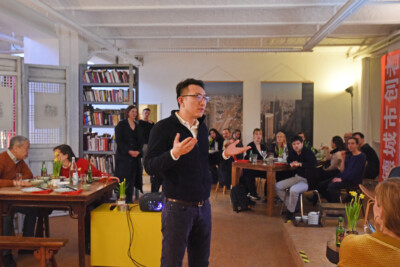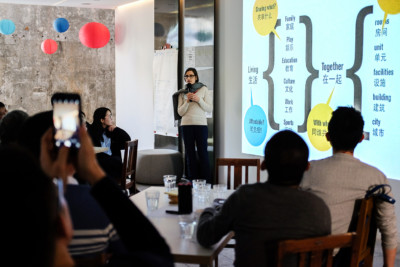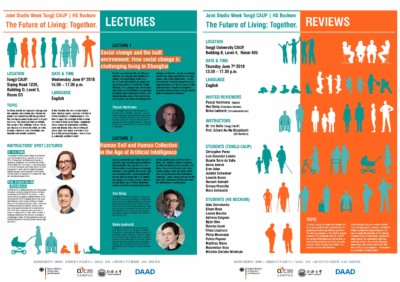The incubator project „Future of Living“ was one of three projects that received support from the CITYMAKERS China – Germany program during its second year of funding. From September 2017 until April 2018, a team of three, Erhard An-He Kinzelbach, Professor for Architectural Design and Construction at Bochum University of Applied Sciences, Germany, and principal at KNOWSPACE architecture +, Iris Belle, Assistant Professor at the College of Architecture and Urban Design at Tongji University, and Binke Lenhardt, founder of and architect at Crossboundaries researched the topic of co-housing and produced a study with co-housing projects in China and Germany. The study was presented at AEDES Architecture Forum in in Berlin in April 2018. We want to know: What happened since then, how did the project continue? On behalf of the team, Iris Belle answered the questions.
Iris, could you first of all summarize the most significant results of your study once more?
The incubator project „Future of Living” started with the observation that people in cities often live in apartments and neighborhoods that add stress to their daily lives: high mortgage payments, long commutes to work, and neighbors who remain strangers even after many years of living wall-to-wall. We have studied alternative housing projects and examined their functional programming, their spatial layout, composition of residents and financial models. We found that co-housing models in Germany are different from conventional residential designs for four reasons mainly:
Firstly, residents share a strong vision about the lifestyle they want to lead. Secondly, living this lifestyle is possible only with the right mix of residents, at a suitable location, with corresponding functional programming and architectural design. Third, a strong narrative about the vision is needed to build the community and communicate with the professionals involved in financing, designing and building the project. Fourth, the community can, through commitments of sharing time, labor and skills offset costs, which makes the community all the more relevant.
We also found that collective living is gaining popularity in China. However, projects show substantial differences from the German models. In Germany, co-housing is largely self-organized by future residents or by small specialized architects/developers who involve future residents early on in the planning process and throughout the design and construction stages. Ownership of the project is for life in the majority of cases. In China, big real-estate developers are branding collective living as a lifestyle product to college graduates and early career employees and entrepreneurs. The promise is to profit from an inspiring community of residents and thus succeed faster in one’s career and private life.
Developers are targeting a group of customers – young white collar workers – who are comparatively affluent and are looking for housing in-between graduation, getting married and settling down. This business model thus does not need to tackle issues of affordability. Social inclusion and ageing in place are not part of this model either, nor is long-term household wealth creation through investment and eventually ownership of real estate. Instead, the collective rental housing that we currently see in China is the upgraded version of a college dorm with a lifestyle theme. It is only a temporary form of housing appealing to white collar employees in their twenties and thirties. The challenge is to reconcile both models and create a form of co-housing for China that is feasible legally and economically and gives residents the security of making it a home for life. In addition, it should make collective rental housing accessible to a broader range of demographic groups including also lower income levels.
And what else happened in your project? As you mentioned before, you also established a LIVING STUDIO in the academic context as a follow-up.
We have taken the topic to school, shared insights from the study with our students and asked them to imagine communities for whom co-housing would be most beneficial. We also continuously present the study and engage in discussions with professionals in the field. From March to July 2018 the Joint Studio “Future of Living: Together” between Tongji CAUP and Bochum University of Applied Sciences has taken place including a one week workshop in Shanghai, funded by the Chinese-German Campus, CAUP and Bochum University of Applied Sciences. Students have conceptualized their visions of co-housing at locations in Shanghai and each of them designed a building or an ensemble for a community of residents the students thought would profit. The designs were visualized in buildings, in plans, perspective drawings, models and diagrams. The results inspired discussions and demonstrations of a variety of architectural and urban design interpretations of the future of living in collective, mixed-use buildings. Proposals range from social utopia, to formalistic architectural design, to almost ready-to-build houses. One of the sites of the design proposal was a workers’ village that originates from the 1950s. Some students rose up to the challenge and designed high density collectively used buildings that would replace some of the existing low-rise buildings. Crossboundaries have conducted a study on the history of workers villages.
So did you gain any new insights through all these activities?
A presentation of the project at the Annual Mainland China Meeting of the Urban Land Institute has challenged us to study the ideas of Shanghai’s 2017-2035 master plan and test how the “Future of Living” model could help to achieve these development goals. Shanghai 2035 identifies a substantial need for affordable rental housing and announces an increase in rental housing by 8-10 percent by 2035. This new housing shall be located close to jobs, parks, cultural infrastructure and public transport nodes. The ambitious plan calls for an understanding how residential space can be designed in a way that offers quality of life, has a mixed-use component and reduces costs. Here we clearly see an application for collectively programmed, designed and used spaces.
What do you think could be the next steps for your project? How do you plan to proceed – try to put your knowledge into practice or proceed in the academic context?
We hope that we can develop our idea further and convince a municipality or developer to plan and design a prototype with us. Since the end of the funding period and parallel to the joint studio, we have worked on the topic of collective use of space and the design of future housing in other projects of our professional life.
With her architecture studio Crossboundaries, Binke Lenhardt has recently contributed a built design to the “HOUSE VISION” project in Beijing. Furthermore, Crossboundaries is currently investigating the application of prefab solutions, with the outlook to implement this into the potential prototype.
Iris Belle is working on a research project where she explores ways of upgrading collectively used outdoor spaces in a Lanehouse Alley in Shanghai with colleagues at Tongji CAUP. Beyond spatial and programmatic design, the study also explores the use of digital tools to strengthen trust among the community of users and set indicators for post-occupancy evaluations.
We hope to use the CITYMAKERS platform to stay connected on the topic and also profit from feedback and the network of the CITYMAKERS community.
In 2019, Berlin und Beijing will celebrate the 25th anniversary of their city partnership. Do you see any possibility to place the co-housing topic in this context and if yes, do you have any concrete suggestions?
If there is a platform we can join during the festivities, we could present the results of the joint studio to a broader audience, ideally at a venue with a community based context. We could present the background of the project and discuss two aspects. How could architectural typologies be transferred and adapted from the German to the Chinese context and what benefits ‘Future of Living’ style co-housing can bring Chinese citizens. This would also be a good opportunity to show the student designs and maybe even include the authors to present their work.
If you could place a call for support to the community – what kind of support could you need?
We are always looking for opportunities to expand the platform which enables us to present the work to an audience to get more feedback or public attention and raise awareness – that can also be during the events of the 25-year anniversary.
We are interested in place making and community building, in occupancy studies that go beyond collectively used residential space but also touch office space and other third places that are not necessarily part of a residential compound. Particularly Iris is interested to discuss academic questions on technologies with a wider group of citymakers. Those are technologies that make integrated planning easier and reduce frictions during operation and reduce material use, like technologies for collecting information to monitor and incentivize responsible use, maintenance and retrofitting of collectively used spaces, and designing governance models for building consensus. And of course, we are all still keen to realize a prototype with a developer.
Prof. Dr. Iris Belleis Assistant Professor at the College of Architecture and Urban Design at Tongji University. She holds a Ph.D. in Geography from Heidelberg University and a Diploma in Architecture from the Karlsruhe Institute of Technology (KIT). In the past, Iris has lead projects as Post Doc researcher at the Future Cities Lab of the Singapore ETH Centre and the Institute for Historic Building Research and Conservation at ETH Zurich and has worked for international projects for multiple international design offices.
Contact
belleiris@tongji.edu.cn
Prof. Erhard An-He Kinzelbachis Professor for Architectural Design and Construction at Bochum University of Applied Sciences, Germany, and principal at KNOWSPACE architecture + cities.
He has previously taught as Visiting Professor at the China Academy of Art, Hangzhou and was Assistant Professor at the Academy of Fine Arts Vienna. Erhard An-He Kinzelbach earned an MSc in Advanced Architectural Design at Columbia University, New York, and studied architecture at TU Darmstadt and ETH Zürich. He is a member of the Association of German Architects (BDA), Berlin, of the Chamber of Architects, Berlin and of the Chamber of Architects and Engineers, Vienna. For his architectural work and teaching Erhard An-He Kinzelbach has received multiple awards.
Contact
ea@knowspace.eu
Dipl.-Ing. Binke Lenhardtco-founded the award-winning architecture practice Crossboundaries with offices in Beijing and Frankfurt. She is also a consultant to the Beijing Institute of Architectural Design (BIAD) and teaches regularly at the Central Academy of Fine Arts (CAFA). Binke holds a Master’s degree in Architecture from Pratt Institute, New York, USA, and a diploma from the University of Applied Sciences, Dortmund, Germany. She is a registered architect in Germany and member of the Association of German Architects (BDA).
Contact
b.lenhardt@ crossboundaries.com





